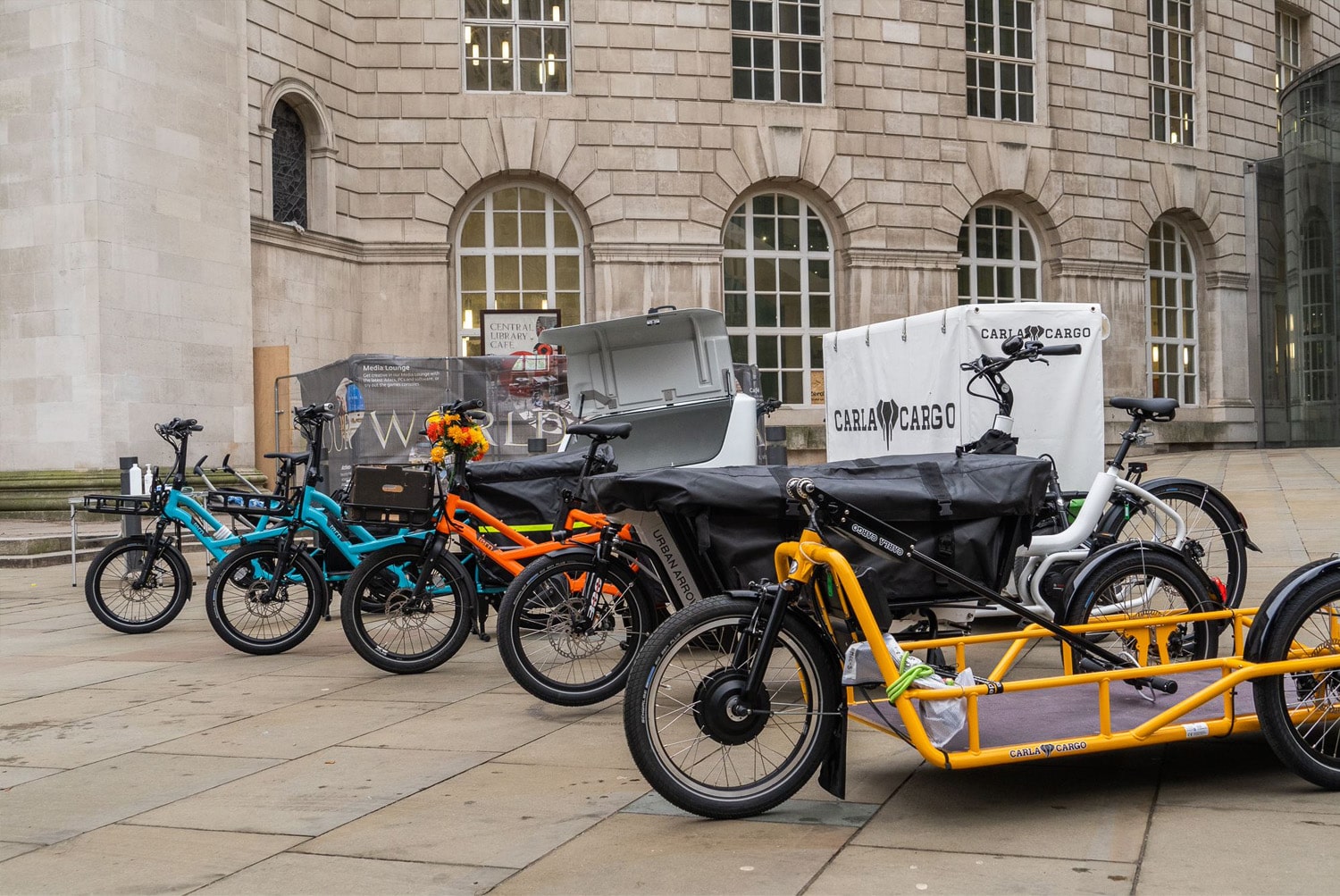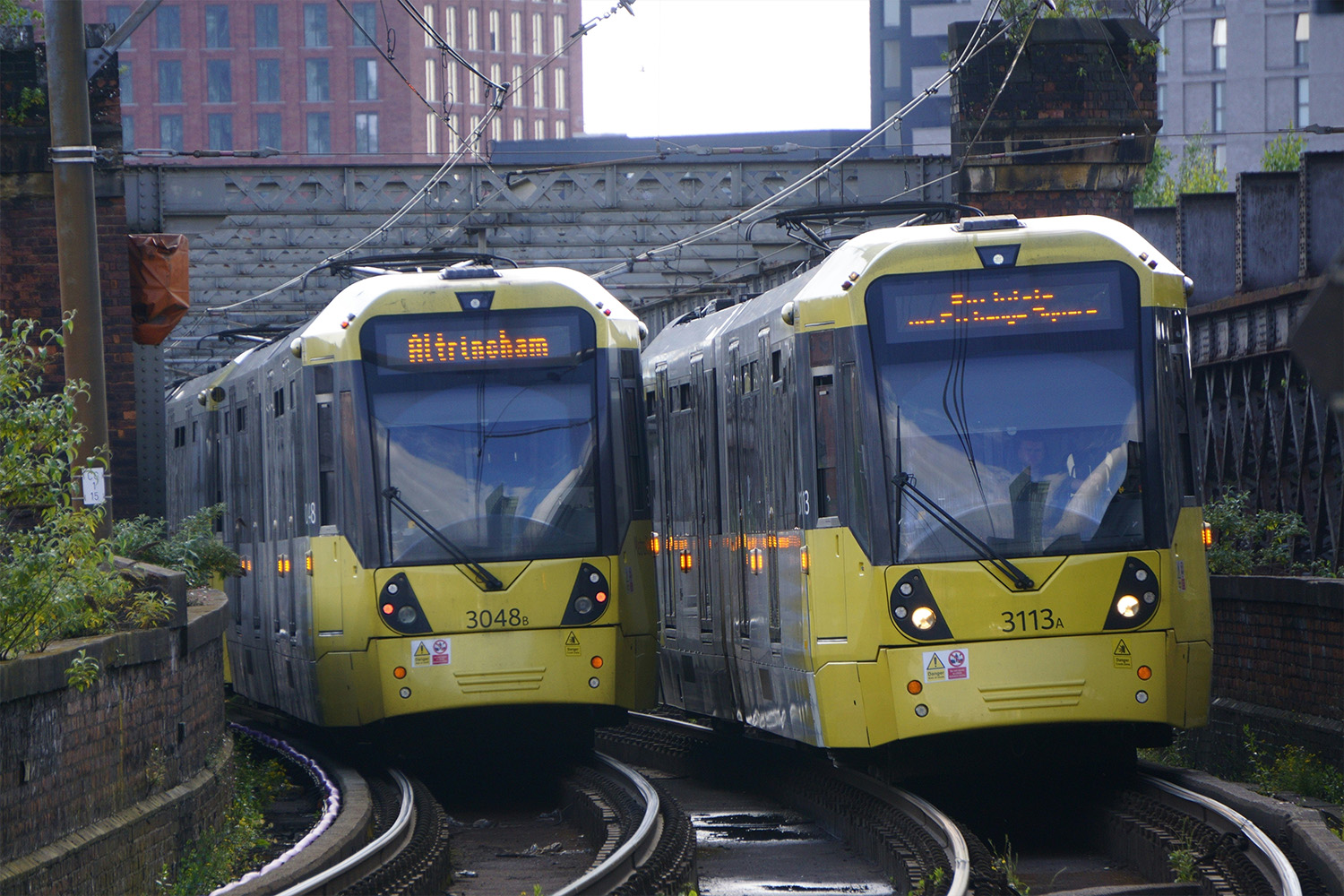Designing bikes or bike lanes?
June 2022
Which has more impact on the cycling experience: the design of the bike or the design of the bike lanes?
Our responsibilities as mobility designers lies far beyond the product or service. This means understanding the changing landscape of city infrastructures. To learn more, I spoke with city transport planners Catherine Osborn and David Wills from Transport for Greater Manchester (TfGM). Catherine and David have both worked for a decade in transport planning in places like Sustrans, Transport for London and the London Borough of Waltham Forest.
Over 30 minutes we covered e-scooter infrastructure, creating accessible streets, multi-modal journeys, building mobility hubs, London as a nationwide benchmark and the role of branding to drive behavioural change.
Listen on Spotify, Apple or Google, or read the highlights below.
Note: views presented by Catherine and David are their own and not those of TfGM.
Better bikes, or better bike lanes?
GeorgeA few months ago we were talking about the design of bikes and e-scooters and you said something really interesting to me David.
Bike designers are trying to create a better ride with things like improved suspension or use of lightweight components. Our discussion was around how this probably has much less impact on the rider’s enjoyment than the designers who (for instance) put a tighter radius onto the corner of the roads.
DavidIt’s quite an interesting question. I definitely think that the street has a much bigger bearing on a journey than the bike or the scooter someone has. A lot of the safety of a journey comes from the environment that they’re in. The incidents that you have are largely not due to the bike or scooter but down to the environment that you’re travelling in.
It’s same for people walking. One of the key things we’re talking about at the moment is the interaction between pedestrians and people who use scooters. A lot of the focus is on making the scooter safer for interaction with pedestrians. But if you have suitable space for people on scooters to ride, space which is safe and separated from people who are walking, you’ll have significantly more impact than just having the scooter make a noise when you’re traveling through a shared space with pedestrians.
Where there is interaction with pedestrians, it’s more around making people that use it aware that it’s shared. In a big town centre where there’s no real delineation between people walking and people scooting or cycling. It’s about making that environment a slow environment for people to interact in.
All of this is going to have a much bigger impact than whatever you design on the scooter.
GeorgeI remember going to Amsterdam and seeing the volume of fast moving bikes moving in all directions. It’s almost overwhelming. I would hate to have a mobility issue or disability that reduced my sensation of the world around me. I could barely track them all, I’m used to a road with a particular spacing and cadence of cars. Just trying to cross a small lane of bikes was almost overwhelming.
DavidA lot of that comes down to way that the streets are prioritised in Amsterdam. Cycling is physically segregated and takes priority over pedestrians in a lot of places.
It’s quite a hard segregation and it’s almost a road in itself for bikes. That has an impact on your perception and experience as a pedestrian. In a city like Copenhagen that segregation is softer, it’s more of a hybrid approach and it’s a much better place to walk around then Amsterdam in my opinion.
CatherineSomething I want to discuss is how accessibility for users with mobility impairments is a significant part of how we design our streets. We look at designing for non-standard bikes, bikes that can be used by a disabled cyclist, but also cargo bikes and trikes. There’s quite a number of people that can’t walk very far but for whom the bike can be a mobility aid and provide a lot of independence.
I went on a ride through south London with a woman on a hand cycle and a woman on a bike who couldn’t otherwise walk very far. Having accessible streetscapes that catered for their specific needs was really important.
We were talking just today about the fact that a cargo bike can unlock huge potential in new ways of transporting goods around cities. To accommodate those users we’re looking at segregated cycling and walking crossings, where cyclists push a button to cross. If you’re on a cargo bike, you’re normally set much farther back from the stop line. So where do you put the push button to cater for all types of users? Bike manufacturing can evolve in various ways and its difficult to keep on top of, but cargo bikes is definitely one that we should be facilitating.

New products vs. new infrastructure?
GeorgeIf we look at e-scooters, in many cities worldwide these came first and then the paint work, signage and legislation came later. I believe the UK is particularly unique because of our historical laws. We had to do legislation first.
A cargo bike is a product which is already very popular in say Scandinavia or Holland, but is not very commonly seen in the UK.
Which comes first, the infrastructure or the products? Because we could see more cargo bikes come and then you’re forced to redesign some of the architecture. Or you can redesign the architecture in the hope that these things will come, but maybe they don’t. How does that balance work?
CatherineTo be honest I think London sets the standards for how these things are done, they are used significantly more in London. Other places in the UK see the opportunity from London and start trying to incorporate that into their design work.
But realistically, the design work we do is a tiny proportion of the streets in Greater Manchester. We hope we can start things off, but the other thing we do besides the infrastructure is behaviour change. We’ve got cargo bike rental schemes for businesses and people in parts of Manchester at the moment. There’s lots of things that need to be tied together to increase the use.
DavidAs we continue to meet our targets to increase cycling, the diversity of cyclists is also going to increase. The overall figure of people who cycle in places like Copenhagen and Amsterdam is a lot greater, and with that you get the diversity of usage because it becomes far more normalised. Cargo bikes are an example, but also non-standard bikes and adaptable bikes will become more and more prevalent.
Safer streets
GeorgeTell me more about designing for people for whom the bike is a mobility aid, rather than just a commuting tool or leisure tool. What does that actually involve?
CatherineWell a big part of it is actually not related to the highway. We look at off-highway routes like old railway line routes and green paths. Very often they have accessibility barriers at either end to stop mopeds using them which is a huge problem for us.
There’s quite a few schemes looking at making accessible routes for prams, wheelchairs and adapted bikes & trikes, which can be quite wide. But at the same time the local decision makers do not want to allow powered two wheelers and mopeds down them. In reality there’s nothing that will really stop mopeds getting in while allowing all types of accessible bikes to get in. So it’s a policy topic, but it’s quite a challenging issue at the moment.
Then there’s things like turning cycles. When you’re designing segregated cycle lanes at junctions you’ve got to turn quite sharply. There’s increasing amounts of guidance around what the standard wheel base length is for certain types of bikes. We’ve got to try and incorporate that in our junction designs, but you’ve got to balance it with the space that you’ve got on streets and junctions. You can only do so much with the space.
DavidIt’s not just bikes though. You’re designing for wider mobility aids: people with wheelchairs, people with buggies. All this street infrastructure that’s in place to prevent anti-social behaviour has an impact on a much wider community.
It takes just one barrier or one lack of a drop curve to prevent a journey being made by an adapted cycle or a wheelchair.
GeorgeI assume there’s also a huge amount of work around unseen disabilities. Things like the positioning of street lighting or provision of space where you can gather or not gather. Getting up and down curbs is the practical side of it, but there’s psychological and emotional safety as well.
CatherineYes, things like seating. There’s a lot of evidence to show that older people walking to (for example) their doctor’s surgery can only really make those journeys if they’ve got seats along the way. But on the other hand you’ve got highway engineers that say if you put in seating you will attract anti-social behaviour. A lot of traditional highway engineers see streets as roads for cars, its very car centric thinking.
There’s a lot of healthy streets indicators: greenery, shade, shelter from the rain, that we’re all trying to incorporate in new schemes. It isn’t always as easy as you’d like it to be.

Multi-modal journeys
GeorgeWe’ve only really talked about individual journeys so far. A lot of what you do must also be linking in where people take a bus for part of the journey and then cycle, or they commute by train and then store their bikes somewhere.
I find this very interesting because the designers of these individual products probably don’t think very deeply about multimodal transport and how that’s going to work.
DavidThe Brompton’s a great example of something you can use really effectively on a multimodal journey.
Increasingly we’re looking at mobility hub concepts with shared mobility options at our rapid transit connections like Metro link and rail stations. There will be shared bikes, cargo bikes and scooters integrated close to the station. We probably need to do more thinking on how you actually use the information on when your train or bus is leaving to support that integration, and increase integrated payment methods between a shared bike and a tram or a train.
Rental collaborations
GeorgeThese rental schemes, are these private endeavours or are they council organised projects?
CatherineIt very much depends. Where I worked previously at the local authority, we were getting approached by lots and lots of dockless bike companies with a lot of foreign investment.
Councils and highway authorities get a lot of people wanting to putting things on the street. The difficulty for highway authorities is the regulation: knowing whether they can trust what’s being said, how long they’re being installed for etc. At my local authority one company ended up investing quite a lot. The bikes were in the area for a year and a half, maybe not even that, and then they were gone. So it’s quite difficult for transport authorities to put the time and effort into supporting them through the regulations. It’s not easy, there’s a lot of legal work relating to all the highways rules and regulations, and then they just disappear when they want to.
It was the same with car clubs, we worked with one car club quite closely and since I left I’ve realised that they’ve pulled out. In London for example you have to work with 32 different highway authorities who have 32 different legal processes and permits for spaces on the highway. It’s a really big barrier. Organisations like Transport for London could have a bit of oversight, but they don’t own the road.
So I can see it from both sides. It’s a challenge for the local authorities to know who to trust and to forecast how it will work, but it’s also a challenge for the companies who might genuinely be offering something but have to navigate such complex policy environments.
DavidIt works a lot better when companies collaborate with local authorities. Before the pandemic we were much more successful in car club delivery because we worked in collaboration with them. We were able to consult on spaces and we’d work with the car club operator to fill them effectively.
It’s similar with scooters as well. For example where we’ve trialled scooter hire in Salford Quays it’s been successful, but we’ve done that in collaboration, managing where the scooters are and where they can operate.
Competing street demands
GeorgeYou mentioned the huge complexity with layers of bureaucracy in London. How is it where you work now in Manchester, who manages what?
CatherineTo be fair, it’s the same. It’s complex everywhere you’ve got regulations for the highways. With bike hire we’d ideally want to free up some parking spaces to put in a bike hire stand as then you’re not taking out pedestrian space, which is often limited. You just have to remove a couple of parking spaces, but to do that you have to go through things like traffic regulation orders and sometimes that’s more controversial than, well, we would like.
Coming back to mobility hubs, there’s a lot of competing demands for road space, especially when you’re looking outside stations. You’ve got loading needs, disabled spaces, bus infrastructure, as well as train stations and Metrolink stations.
Then when you’re looking at micro mobility and creating space for scooter bays or bike hire, you can see how it really mounts up. Plus you’ve got residents living in that area as well. That’s the sort of thing that I’ve worked on before and there are big challenges associated with that.
DavidAnd on top, in our town centres that space is privately owned. So it’s not even under the highway authority’s management. Private companies own and manage the space in key locations within greater Manchester and across the country.
London as a benchmark
GeorgeYou’ve been doing this for over a decade, and there’s been a lot of change in that time. These scooters we’re talking about, we wouldn’t have mentioned them if we’d had this conversation 10 years ago.
What do you see coming? What do you hope for, in terms of the way all these modalities blend, evolve and develop in cities in the future?
CatherineHaving been to visit London recently, you get a really strong reminder of how much better it can be.
Most UK cities outside of London will aspire to have a public transport system that’s as good as London. The main way to get there is accessibility: creating more accessible streets for all users. For me that means reducing the number of short journeys that are done by car.
I think we should be open and a bit more ambitious in what we trial, in terms of enabling people to choose different modes and different options like scooters, for example, as long as we can do it safely to make those short journeys.
GeorgeWhat is it about London that is particularly good compared to other cities in the UK?
CatherinePartly the bus system, which is a lot better as its franchised not privatised, along with the integration of the Oyster card where you can jump on a bus and have a capped fare between buses and tube system. Multimodal journeys with the tube and public transport system is something that I think most cities aspire to improve on.
Having originally worked in London almost 10 years ago, I was also amazed recently by the hugely improved number and diversity of cyclists.
In the future, do you think these two wheel vehicles will continue to be predominantly privately owned? What do you think the balance will be between the rental model, shared ownership and privately owned?
CatherineI think there’s a big case for both. The best thing about cycling is that you can get a bike for 50 quid and that can be your main mode of transport in a city. Having the ability to hire a bike as well is important, but the second-hand market is really important for cycles and there’s a really big case for strengthening that.
DavidThe shared mobility aspect is really important for integrated journeys. It’s a lot less hassle to borrow a bike at the end of a rail trip to get to your final destination.
It’s a lot easier to get off a tube and borrow a bike or scooter at the end of a rail trip to make that last leg of the journey. That’s where integrating and making the shared mobility aspect work is really important.
You asked about why London was better. I think Catherine answered that really well, but it’s also the density of London.
We talk about a 15 minute city in Manchester, where you can access all your key amenities within a 15 minute walk. It’s hard for us because we’re less dense, but in London that does exist. It definitely enables people to walk and cycle more because it’s much more reachable. It has an impact on the number of people driving and then car trips as well.
GeorgeYou mentioned how important the shared schemes are for multi modal journeys. What do you think is the barrier to more adoption of these schemes? Is it related to the products themselves, for instance their desirability and branding. Or is it about things that are not controlled at the individual product level, like the utilisation rate or guaranteeing availability before you get there?
DavidI think in many ways it’s the infrastructure in the cities. Scooters and shared bikes are very popular in London where you’ve got quality infrastructure on main roads and lower traffic roads surrounding those areas. If you look at where they’re most successful, it’s where good street infrastructure enables safe and comfortable journeys by those modes of transport.
Linked to that is working with local authorities to make sure they’re in the right place, they’re well managed and there’s enough of them to cater for demand.
We’ve just launched a bike hire scheme in greater Manchester. It’ll be interesting to see how successful that is.
CatherineFrom my perspective, I think the public and the decision makers are very risk averse.
Any company needs to make quite a strong case as to why a product will be safe, well-maintained and in it for the long run. These are really important barriers to rolling schemes out on a wider scale. Personally, I hope that they can be overcome. I hope the case can be made for them.
Behavioural change through branding
GeorgeAnything that you think is important that we haven’t spoken about yet?
CatherineYou mentioned before about branding. The other side of this is behaviour change, influencing people to make decisions on how they choose to make a journey. Making something cool and fun, or bold, bright and exciting, is a really important part of that.
We need to look at different demographics and make sure there’s something for everyone. Perhaps there are opportunities to market certain micro mobility solutions to older populations in a slightly different way to young teenagers. It’s all about trying to convince as many people as possible to do short journeys in any way than by car, which as we know is causing a million problems: sedentary lifestyles, the health issues of sitting rather than moving actively, climate change, congestion. There’s many angles to it.
GeorgeUsing branding to create desire amongst people for a positive behavioural change: is this something that you see people caring about and designing for at TfGM? Or do you think it’s generally left to private enterprises to really do this.
CatherineI think it needs to be both, but we do have a really good comms team that use really inclusive imagery in their marketing. They need to do it, but also private companies can help as well. It can all play as part.
GeorgeDo have an example of a public sector transportation project that you think did that really well?
DavidThe Bee Network promotional videos for our active travel network videos are excellent. They really emphasise the normality of walking and cycling. It doesn’t do anything particularly flashy, it just normalises how people get around on foot and bike and the transformation you can see in your streets by having them less car dominated.
A lot of people see Transport for Greater Manchester doing pretty well. TFL also do very well. In terms of making something really fun I’m sure there are lots of examples, I just can’t think of them off the top of my head.
GeorgeAlthough from my side, I’d say that fun might not always be the right adjective. A lot of people don’t want a fun ride. They want a calm ride or a silent or stress free ride.
DavidYes, true. It’s about pitching it a different audiences. But it’s also presenting it as a normal thing to do. People want to do what other people do. As you reach a critical mass of people cycling and walking in a city centre it will become a more normal thing to do that will promote itself effectively.
It’s that initial buy-in that you need to achieve that.
GeorgeAbsolutely. Thank you both for your time, that was really great!
If you'd like to read more, please take a look at the Greater Manchester Streets For All strategy, which David is heavily involved with.

